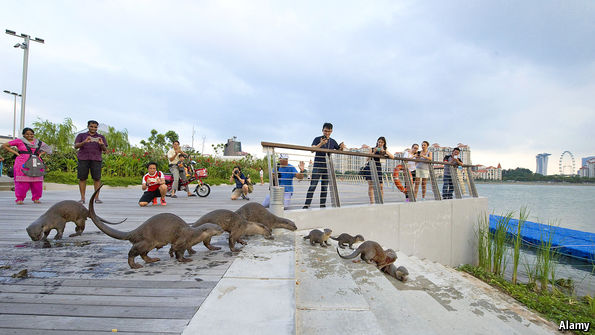WHEN Australia’s prime minister came to visit Singapore last year, his local counterpart took him to visit not the Merlion, a statue of a mythical creature adopted decades ago as a national mascot, but the Bishan Ten—a photogenic family of otters that have become something of a national obsession. In early August Singaporeans chose the Bishan Ten as the official emblem of their country’s 51st year. A state media firm has produced a documentary on the family, narrated by Sir David Attenborough. And the city-state has just hosted the 13th International Otter Congress.
Otters had disappeared from Singapore by the 1970s, as rubbish, farm waste and sewage clogged its few short rivers. But in 1977 Lee Kuan Yew, Singapore’s independence leader, ordained a clean-up, as part of his vision to turn Singapore into a “garden city”. “The river went from black to clear in less than a decade,” says Sivasothi, also known as Otterman, a lecturer at the National University of Singapore.
As the rivers grew cleaner, fish populations returned. By 1998, the first otter families began to return to Singapore. Most stuck to the island’s less developed north coast, along the border with Malaysia. It was not until 2014, when the Bishan Ten colonised a park near the city centre, that the otters really began to loom in the public consciousness.
Groups sprang up on social media to trade sightings and suggest good otter-spotting locations. Singaporeans gasped collectively on the day the otters were separated from one of their pups, Toby, and sighed with relief when they were reunited, with Mr Sivasothi’s help. They tutted and chuckled when the otters were accused of scoffing $60,000 of designer carp.
The return of otters to the city is proof of the success of Singapore’s efforts to green itself. Although it is the world’s second-most densely populated country (after Monaco), the government has set aside approximately 8% of its 719 square kilometres (277 square miles) for parks and other green space. It has promised that 85% of Singaporeans will live within 400 metres of a park by 2030. An area of rooftops equivalent to roughly 100 football pitches has been planted, with more on the way. The city-state is becoming what Mr Lee, who died last year, always thought it otter be.
http://www.economist.com/news/asia/2...on?frsc=dg%7Ca





 Reply With Quote
Reply With Quote
